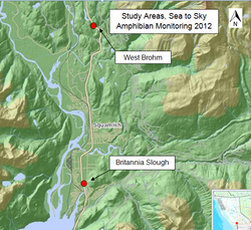Britannia Slough Wetlands Compensation Project
Funding support:
Ministry of Transportation and Ministry of Environment
|
|
Project Background
|
In preparation for the 2010 Winter Olympics, the Highway 99/Sea to Sky underwent major upgrades including a 1.9 km realignment of Pinecrest Estates that required infilling of several wetlands. This wetland complex provided habitat for six aquatic breeding amphibians including the Red-legged Frog (Rana aurora), which is a Schedule 1 species of special concern on the federal Species at Risk act, and a Blue listed species of concern on under the BC Wildlife Act.
Through the highway realignment, both permanent and ephemeral wetlands were lost and 1037 amphibians, including 683 Red-Legged frogs, had to be salvaged. To compensate for these impacts, the Ministry of Transportation provided funding to the Ministry of Environment to facilitate habitat restoration to benefit Red-legged frogs. The SRWS had done previous bio-inventory work for the Highway 99/Sea to Sky improvement project and in 2011 the Ministry of Environment retained the SRWS to carry out the wetland restoration project. |
Site Location
Wetlands were created on the West side of Highway 99/Sea to Sky and North of the Squamish Adventure Centre. This area is also known as the "Mamquam Reunion".
Objectives
To build eight wetlands for amphibians, including the blue-listed Red-legged Frog, in compensation for wetlands lost through the Highway 99 upgrades.
Works Completed
12 sites were identified for restoration where shallow temporary wetted areas existed. An excavator dug pits to depths between 1.8-2.5 m creating a total of 8 ponds, 5 on the west side of Highway 99 and 3 on the east. Groundwater quickly filled excavated sites and rainfall later added to levels. Ponds vary in size and shape, ranging from 300-1200 m² and are linked by ephemeral trenches of varying depths. During peak rainfall most ponds sites are connected and surface areas can grow to 2,000 m². Using on-site trees, woody debris was added to pond and riparian zones to create complex features including root balls, log crossings and twig debris The SRWS leads ongoing re-vegetation projects in this area to support this wetland habitat.
Post-restoration Monitoring
In our 2012 habitat monitoring of the Britannia Slough Wetlands, five aquatic-breeding amphibian species were observed in the eight ponds and also at a shallow depression in the trench between ponds. This included Northwestern Salamander (Ambystoma gracile) and Long-toed Salamander (Ambystoma macrodactylum) egg masses, and Western Toad (Anaxyrus boreas) and Pacific Chorus Frog (Pseudcaris regilla) adults. Red-legged Frog adults and egg masses were both seen.

